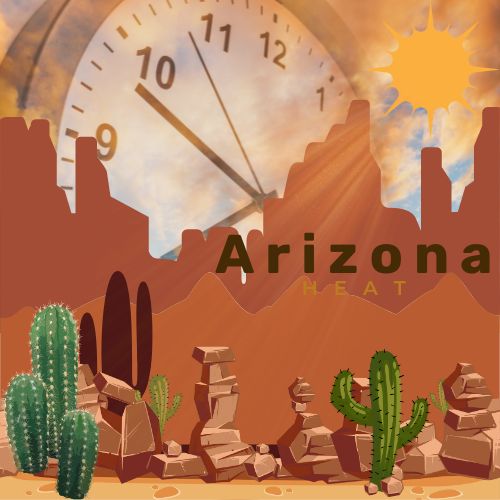Written by COLTON KOBSAR
Graphic by COLTON KOBSAR

// It doesn’t take a mastermind to know that Arizona is exceptionally hot during the spring and summer months. However, to be so hot to a point where the state as a whole can’t even handle an extra hour of sunlight like the other “desert states” of Texas and New Mexico is a whole other extreme. After reasonable concern from the public to do so, the state of Arizona decided not to recognize daylight savings (DST) in the years succeeding 1967 to combat the effects of their climate. The state backed the Uniform Time Act with a draw to its incentive for energy conservation, arguing that activities require much more energy when they undergo in high temperature environments. Switching to DST in the summer means more sunlight at night, which in turn means homes don’t have to turn on lights as early. Historical incentives for this decision, based entirely on goals for sustainable statewide development, have been forgotten in the modern era due to the rising dilemma of climate change. More people now cherish the absence of daylight savings time because of its impact in making the desert a more suitable place to live as a resident in Arizona.
\
Relieving the population of the hot sun for an extra hour in the day allows more time for people to participate in activities that otherwise would be adversely affected by the climate. An Arizona Republic editorial from 1968 (only a year after the act was passed) even stated that, “Drive-in theaters, the parents of small children, the bars, the farmers and those who do business with California” were against daylight saving time, while “power companies, the evening golfers, the late risers, and the people with business interests on the Eastern Seaboard” were for it. A great divide still exists between the real need for this modest, but arguably vastly influential, change in time. With this act in place, Arizona is on Mountain Standard Time for one half of the year and Pacific Standard Time for the other. This variation allows for distinct changes in market conditions during certain parts of the year, and in turn may disrupt basic operation of business for those in Arizona working an hour ahead or behind the time zone of major western metropolitan areas (e.g. LA or Denver). Upon greater examination, it is of importance to note that not all citizens of the state of Arizona use such a metric of time. There exists an outlier in the general population, that being the Navajo Nation. Although their neighbors in the Hopi Nation observe the same time zone as the rest of the state, the Navajo Nation has still remained loyal to the long-adored, rather questionable tradition of daylight saving.
/
Despite the fact that there have been recent legislative efforts to rebel against this annual transition of time zones, like those in California, the status of “springing forward” and “falling back” is relatively far from extinction. So for the time being, Arizona will remain the topic of discussion for this issue … and sure enough, the question will arise once again come November: Why doesn’t Arizona participate in daylight saving time?




Leave a comment